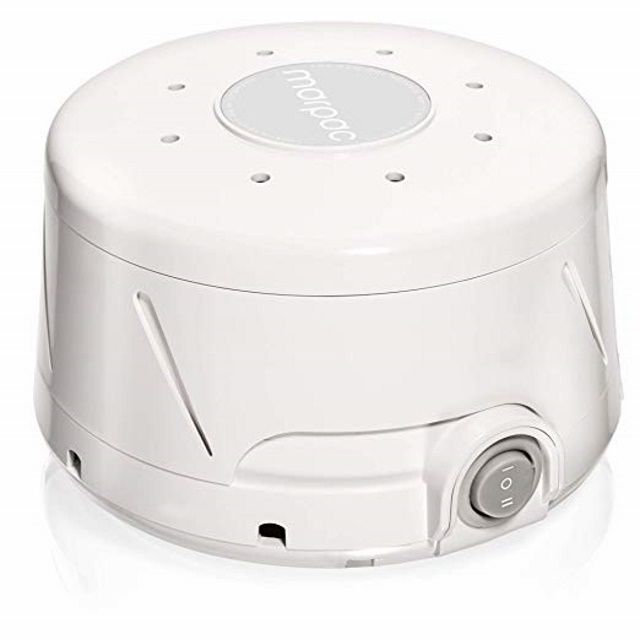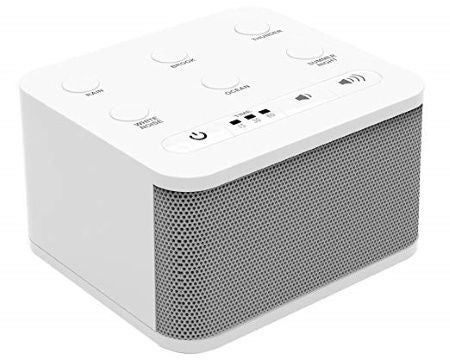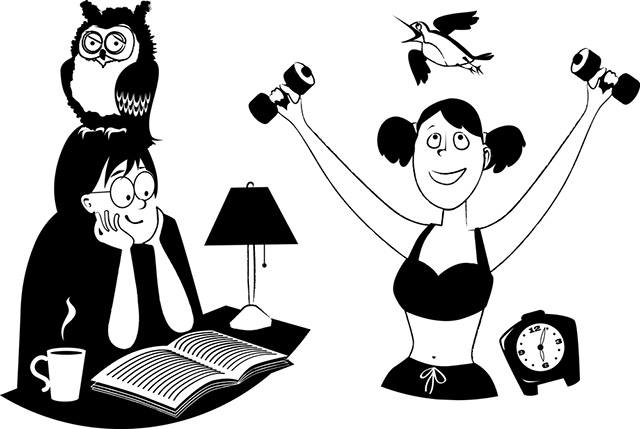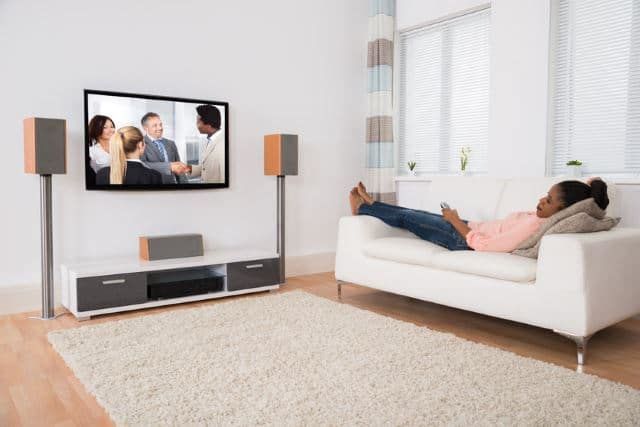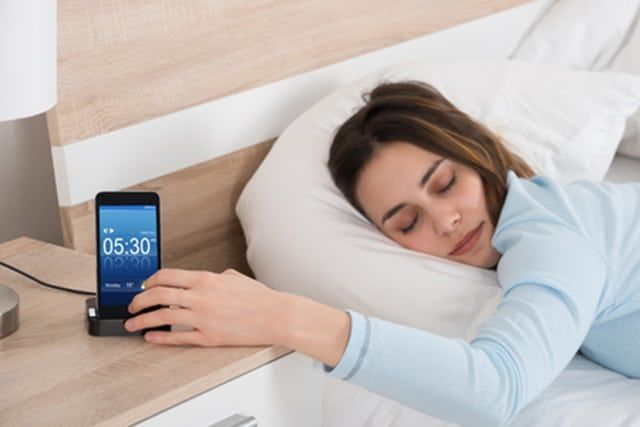Sound plays a factor in many aspects of our lives, and that means our ears get a real workout. But sound can affect you in a negative way when it becomes noise that doesn’t serve a purpose. And when you’re trying to focus on something specific or even tune out the world around you, noise can really factor into your ability to stay targeted on the task at hand. Sound is required for communication on many levels, whether between people or between you and an object (such as an alarm). However, noise is an unnecessary distraction.
Let’s Take a Closer Look
A sound machine that produces white noise can really help reduce the effects of noise in your environment, whether during the day to help your concentration or at night when you need to fall asleep. It’s been proven that white noise – and other ‘colors’ of noise – can aid in building space more conducive to sleep or focused activities, as well as creating a more peaceful and productive life that leads to greater health and happiness.
How is this possible? To know how it works, you first need to understand the definition of white noise, how and why noise is classified by color, and how sound itself is constructed, as well as how better sleep and concentration can literally keep you healthier.
The Basics – What is Sound?
We hear sounds every day, and those sounds (including noise) range in volume and pitch. A bird tweeting is a much higher pitch than the rumble of a semi-trailer passing by. How is sound constructed so that you get these different pitches, and how do you change the volume and intensity?
The best way to explain sound is with light so that there is a visible example. Both light and sound travel in waves. Light moves much faster, but the principle is the same. The waves are measured in two ways – wavelength (frequency) and height (amplitude). The length of each wave, or frequency, determines the color of light, with lower frequency producing red, orange, and yellow – on one end of the spectrum – and blues or purples with higher frequency on the other end of the spectrum.
For sound, lower frequency – or wider, longer waves – produce lower pitches or deeper sounds. Think the bass versus the violin. Higher frequencies – narrower and shorter waves – produce higher pitches, such as a flute or birdsong.
The amplitude is the intensity of the light and sound. With light, this is brightness. With sound, it’s typical volume. So, a taller wave (higher amplitude) is more powerful and, therefore, louder. So, with sound sort of mimicking the way that light works, the classification of sound in ‘colors’ makes sense.
What is White Noise?
You may want to read: Best White Noise Machine
Sound machine white nose reviews of particular models will give you various bits of information. But to understand what white noise is, you can again compare it to light. With light showing up as multiple colors depending on frequency, it might be hard to see where ‘white’ fits into the spectrum. Technically, it doesn’t. White light is created when all light frequencies come together, so white light is a blend of all other colors. That’s why, when you shine white light through a prism, it refracts, or separates into a rainbow. It pulls the colors apart into the individual frequencies.
White noise is also defined as the coming together of all frequencies of sound. The human ear recognizes, on average, about 20,000 frequencies (or pitches), ranging from 20 Hz to 20 kHz. Some people can hear lower tones, and others can hear higher pitches, but this is the general range. White noise incorporates all 20,000 of these sounds at equal amplitude, or power (volume), so that you can’t separate one sound from another. The result is that the sound you hear is a lot like what happens when you switch the television to an unused channel and get the ‘popcorn’ on the screen. It’s that general hissing sound.
Sound in Color
Describing sound with color makes it easier to understand since this is one way it can easily be visualized. And because you learn about the rainbow and the spectrum of light in grade school, the comparison is simple to comprehend. Therefore, the sound has been labeled so that the colors of the separate frequencies of light apply to sound in a similar way, based on the lower or higher frequency of the sound. While white noise is generally accepted as a great background to help you concentrate or fall asleep, understanding the various sound colors can help you determine if a different color of sound might work better for you.
Does it Work for You?
Some people find that white noise is literally too harsh for it to be soothing, and this makes sense because some people are overly sensitive to the intensity of white light. Because white noise blends every audible frequency of sound, it can be a bit harsh for some people, and there are no sunglasses that can protect against the intensity of white noise. Therefore, you might want to consider the possibility of utilizing one set of frequencies rather than the conglomerate of all of them. In fact, you’ll find that most of the things you hear in nature, or those that are often labeled as providing ‘white noise’ (like ceiling fan) are actually not white but actually a single color along the spectrum. In many cases, the pleasant sounds you hear are actually pink noise.
— Pink Noise
Do you like the sound of a rainstorm as the drops hit the glass on your window or the siding of your home when there’s no hail or thunder to interrupt it? This is probably one of the best examples of what pink noise sounds like. A lot of indoor fans that provide background noise are pinker in quality than white. Pink noise is a blend of lower frequency sound waves, which create lower pitches on the spectrum, just as the red light is made with lower frequency light waves. Why is pink noise often more soothing than white noise? Remember, white noise carries all frequencies of sound, including higher pitches. And while they are all at the same amplitude, human hearing is more susceptible to the higher end of the spectrum. This is likely why babies’ cries are high pitched – it gets a quicker response.
That means that we’re less affected overall by lower tones, and they can be more soothing in the ‘background’ without prompting action. Also, in nature, pink noise is more ‘level’. What does that mean? It means that these lower tones, even as they increase slightly in pitch, decrease in amplitude by equal amounts. So, the overall effect is that pink noise is very constant and consistent in tone and volume. This is not the case for all categories of sound. In fact, a study in 2013 proved that people are more likely to achieve a deeper sleep when provided with pink noise as a background than with white noise.
— Brown Sound
Take the lower frequency a step further, and you’ll have brown noise. Now, brown is not in the color spectrum, and brown noise is not actually named for the color brown. Instead, it’s short for ‘Browning’. Brownian motion is the name for how random particles move in liquid, and the term ‘brown noise’ comes from this. In short, brown noise is like pink noise but has even more bass and lower pitches. These lower frequencies can also be soothing. To give you an idea what it sounds like, listen to the deep sounds of the strong winds of a powerful tornado in the distance (as opposed to the higher pitched winds of a tornado directly overhead or the squeal of straight winds in a hail storm).
— Blue and Purple
Federal telecommunications standards don’t define all colors of noise that are identified and generally accepted, but pink, brown, and blue noise are. Blue noise is literally at the opposite end of the spectrum from pink noise, just as it’s opposite red in the light spectrum. Blue (and purple) noise refers to the blending of the higher pitches (shorter wavelengths and higher frequencies) within human hearing. To try to illustrate how blue noise sounds, think about the high-pitched sound of a spray coming out of a water hose as it hisses.
Like brown noise compared to pink noise, purple noise is the extreme of blue noise. One of the biggest problems with blue and purple noise and their ability to irritate rather than sooth is that, unlike pink noise, the intensity increases with the frequency. So, the higher the pitch gets, the louder the volume gets. This creates an imbalance in the overall tone you hear and can make it difficult to focus, especially since the volume can change with the random sound quality and blend.
— Gray Noise
Among those colors not recognized by the federal telecommunications standards but are still classified is gray noise. Unfortunately, this isn’t a level of sound that can be described by example because it is individualized by each person based on their unique hearing curve. Many people with hearing problems or who have tinnitus (constant ringing in the ears), or hyperacusis (defined as hypersensitivity to the normal range of sound), can be treated or assisted by devices that provide calibrated gray noise to help decrease the effects of their condition. So, gray noise is applicable as a sound that is specific to the user.
— Green Noise
Green noise also isn’t clearly defined by these standards but is notably the sort of midrange sounds you’re used to. Consider that green is literally the center of the rainbow – which also puts it at the center of the light spectrum in terms of frequency. The same is true with sound. Green noise falls about midrange in terms of pitch, which is about 500 Hz. Aside from being midrange, these sounds are also often those found in nature, or ambient to the environment, which makes the term ‘green’ dual purpose. Consider the hum of technology as well as the sounds of wind rustling through leaves in the trees. These are both examples of green noise.
— Orange Noise
You may or may not hear people refer to orange noise. Orange is used to describe the unpleasant cacophony of dissonance or discord when a bunch of sounds or frequencies clash and lead to what feels like chaos. Most sounds will blend into harmony or symphony. With orange noise, you can think of what happens when you walk into a concert hall and the orchestra members all have their instruments out, tuning them and warming them up individually with different notes. The sound waves in these cases ‘bounce’ off of each other rather than blending and create that unsettling feeling of orange noise.
— Black Noise
When you see the color black, you may not think too much about it, but it’s considered to be the absence of all light – and therefore color. Black noise is defined similarly, though it’s more theoretical than anything. consider the fact that every moment, every breath, produces some sound, and therefore, without having a perfect vacuum with no sound waves at all, you can’t reproduce the absolute silence of black noise. However, the idea of black noise does exist.
How White Noise (and Other Colors) Can Benefit
The number one way that white noise can help you is through aiding you in getting you to sleep and, in many cases, sleeping more deeply and longer. This is especially important because getting enough sleep is becoming somewhat of an epidemic in society. Consider that, as you age, your sleep needs and your sleep cycle change, and often, those changes don’t tend to coincide with each other, leading to difficulty sleeping.
Then, take into account the growth factors that can be disruptive to sleep in terms of technology – cars, television, computers, phones, etc. Weather changes can make it difficult to sleep as well. Add to that having a family who may move around at night or need you at some point and wake you up, as well as ailments that interrupt sleep like restless leg syndrome, night sweats, or even an aching muscle – and you have a recipe for disaster.
Consider all the factors that create noise – the movement of people, devices humming, and so on. Now, think about the fact that white noise is a blend of all of these and more. Using a sound machine that produces white noise (or even pink noise) can help you sleep by ‘covering up’ these sounds, allowing them to blend into the ‘static’ of the white noise or the thrumming of the pink noise. Then, they don’t come as individual distractions that keep you awake.
You’ve already reduced the possible distractions by more than half. In addition, white, pink, and brown noise are proven to ease the mind, soothing the thoughts that spin circles and keep you awake by relieving the stress and quieting the concerns on a psychological level. And because the frequencies are produced at equal amplitude (volume), there is nothing that stands out to capture your attention and keep you awake.
But sleep is not the only positive effect of white noise and other types of noise. Consider several other aspects of life that are altered with sound devices. You can even get sound machine white noise online via Youtube, and app, or other channels and use through your smart device to test and see if it’s right for you before buying a machine.
Why Else Consider White Noise?
You may be interested in: Best Quiet Fans for Sleeping and White Noise
Anything that offers multiple benefits is worth the investment, and a sound machine that produces white noise and pink noise can achieve this goal. Consider that white noise is beneficial in so many areas that there are people who have been able to cut back on or quit using medication for some conditions and ailments simply based on incorporating a white noise machine into their lives. Here are some ways you might not have realized background noise could be helpful.
Improvement in Concentration – It doesn’t matter where you are or what you’re trying to do; white and pink noise can help you concentrate. At the library, at home, at work, or on public transportation, you have distractions in people and sounds around you. Adding white noise or pink noise to your surroundings will help you make those sounds ‘disappear’ and will also cause some of those excess thoughts that interrupt your focus to fade away.
Reduction of ADHD Symptoms – If outside distractions and internal musings make it difficult for everyone to focus, imagine how hard it is for someone with Attention Deficit Hyperactivity Disorder or ADD to concentrate. White noise has shown a great deal of promise in significantly reducing the symptoms of ADHD and helping patients to focus on the task at hand without interruption. They experience more clarity and have less trouble finishing projects and assignments with less anxiety surrounding the attempts as well.
Higher Levels of Productivity – Because you’re more focused, have fewer distractions, and aren’t dealing with scattered thoughts while trying to work or study, you’ll find that the level of productivity in all aspects of your life increases. Better sleep also helps with this, since you aren’t tired.
Mental Clarity – If you struggle with anxiety and can’t seem to get your mind to settle, white noise can help. Just as it helps calm those random thoughts plaguing you at night, it can help ease them during the day so you aren’t as tense and stressed, leading to better overall health based on reduced anxiety.
Better Meditation – With the ability to clear your mind, you’ll also experience better results from meditation through the use of white noise or pink noise. The whole idea of meditating is to leave the ‘real world’ behind and pull your mind out of your surroundings and into a peaceful place. if you have a ton of distractions around you, that’s fairly impossible. Using white noise will help you slip into your meditation faster, keep you in a deeper state of meditation, and have you feeling more refreshed when you’re finished.
More Peace of Mind in Your Surroundings – You’re surrounded by noise and activity everywhere – a busy office, traffic, noisy neighbors in an apartment building with thin walls, children playing outside your house in the yard next door, dogs barking at passing cars…you get the idea. White noise helps you find that peaceful calm you need after a busy day when you just want to relax and drown out the world around you for part of the day.
Security and Privacy – Consider that, sometimes, it’s not that you want to block everything out from your world, but that you want to make sure no one else is listening in. Children can have prying ears, and especially in close quarters, neighbors might be able to hear you. The same is true at work. Having white noise or pink noise to help drown out a private conversation can go a long way in keeping prying ears from delving too deep into private business.
Pet Anxiety – Whether you have a dog that is over sensitive to the surroundings and barks at everything or a nervous cat that hides at the slightest sound, white noise can help reduce their anxiety and quiet the barking that can wreak havoc on your own emotions as well as make your cat more sociable. In addition, when rainstorms and thunderstorms come around and cause greater stress on animals, you won’t have that issue because those sounds will blend in with the white noise so your animals barely know the difference.
Less Dizziness – People with vertigo can also benefit from white noise. Studies have shown that having white noise in the background decrease instances of dizziness in both vertigo patients and those who waken in the middle of the night, leading to a reduction of falls and potential injury for both types of people.
Tinnitus – This condition causes a ringing or buzzing in the ears that never goes away. The sounds of daily life make it so that it usually isn’t a problem during the day since the background noise helps patients to ignore the tinnitus. However, in quieter times, it can be plaguing. White noise helps the buzz or ring just disappear into the background so that it isn’t a distraction, which also reduces headaches and also helps with sleep.
Again, white noise might not be the answer for you, if you find the combination of all the various frequencies of sound to be a bit too ‘bright’ as it were. But many white noise sound machines also provide other sounds, including nature, sounds like waves rolling in or rainstorms. Some have various pink noise tracks, and others even include natural ‘home’ sounds, such as various types of fans or quiet motors that provide a sort of pink noise in the background. Finding a white noise machine that has multiple options can assist with finding the right track for the right purpose. In fact, you can use one sort of track for sleep and something else for studying or working, so that you get the right blend for the right purpose.
— Sleep – Essential to Health
There is no aspect of self-care that is more important than proper sleep, and that’s both amount and quality. A lack of sleep leads to all sorts of ailments, not the least of which are reduced the effectiveness of the immune system and increased risk of dementia and Alzheimer’s. white noise is a great way to help you get more sleep, which can assist you in maintaining good health in a number of ways, as well as improving your overall quality of life. Proper sleep habits have shown, through decades of study, to be beneficial in these ways and more:
- Improved heart health (reducing the possibility of coronary diseases and heart attack)
- Lower stress and anxiety
- Less likelihood of depression and reduction of symptoms of depression
- Longer attention span
- Greater overall memory retention
- Greater mental capacity and cognitive ability
- Reduced dizziness and symptoms of vertigo, leading to fewer falls and injury
- Faster healing from illness and injury
- Improved immune system
- Higher levels of productivity for personal and professional purposes
- Increased life span
Determining the ideal amount of sleep is not just guesswork, which means that, when you hear that 8 hours is optimal, it’s not just some generalization. Literally, decades of studies have culminated in the determination that for the average individual, between 7 and 8 hours of sleep a night is optimal for health. In fact, these studies have also shown the detriments of not adhering to this idea. Not only are those with less than 6 hours a night on average at greater health risk than those getting the proper amount of sleep; so are those who sleep more than 9 hours a night on average. In fact, people who get the right amount of sleep but don’t rest well aren’t far behind in the category of risk.
— Sleep Habits
One factor in this is that age changes sleep habits. You typically need a little more sleep as you get older, but life, aches and pains, conditions you have, and certain distractions can lead to getting even less sleep and disruption of your circadian rhythm, or natural sleep cycle. With so many things working against you, it becomes even more important to strive for success in getting proper sleep.
— Improving Sleep Habits
While some studies have focused on issues that disrupt sleep, others have looked for ways to improve it, providing plenty of evidence that white noise and pink noise can make a world of difference in this aspect. For example, the Johns Hopkins Hospital Sleep Disorder Center has worked on studies that show how useful white noise can be in creating the right sleep environment. Another study showed that white noise is an ideal way to cope with the sorts of disruptive noises in an intensive care unit so that patients can sleep and heal faster. Even a survey conducted in 2008 by Consumer Reports showed that white noise has been successful in treating sleep disorders.
— Children
Sleep habits are of concern for people of all ages, and that includes infants and children. We should be concerned about getting enough sleep like adults, but we should be just as concerned that our children are resting well every night. White noise can be extremely beneficial here, as well.
— Babies
Think about the use of mobiles with music that lull babies to sleep – thus the term ‘lullaby’. But what happens once the music stops? You’ll find that your baby is more susceptible to any little noise waking him or her up because there is nothing but quiet and distractive noises in the background. With a white noise machine, this is avoided because you can set most of them to run all night without interruption.
You also don’t have to worry about differences in volume, as they are made to have a constant and reliable volume that soothes. Another bonus of assuring that your infant sleeps soundly is that they awaken less and interrupt your precious sleep less so you are more rested and better prepared to care for your child.
You may want to read: The Best Sound Machines for Kids
— Teens
Also, consider the predicament teens find themselves in. They are going through extreme growth mentally, emotionally, and physically. They have to deal with puberty and body changes with large growth spurts, learning about society and how to manage this amid these problems, and the emotional changes caused by hormones and the adaptation to the new social aspects of growing up. All of this means that they require more sleep. However, due to the stress all of this causes – and sometimes, the literal aches and pains – they have trouble achieving even the normal amount of sleep. Also, consider that they have the pressures of schoolwork and likely find it difficult to concentrate on this with the surrounding distractions, whether at school, the library, or home.
White noise is a great solution for all of this. It will help ease the overall stress a teen feels, add focus while studying by reducing the effects of background noise and calming, and work toward less anxiety when it’s time to fall asleep.
White noise also aids in other sleep conditions, reducing bouts of insomnia and, therefore, reducing fogginess and body exhaustion. It has also been successful in helping to treat the effects of tinnitus, especially in the quiet of a dark night as you try to fall asleep, reducing the level of sound ringing or buzzing in your ears as it blends into the background noise.
Why You Should Avoid TV and Music
It’s pretty common for people to have their own means of controlling their sleep habits, but what you may not realize is that you’re doing more harm than good with many of these options. Consider the use of music playing in the background or leaving your television running as you drift off. These things may be helpful at first, but you aren’t thinking about the detriments of continuing this way.
In a way, the TV or radio can help as background noise, covering up the sounds of traffic or ticking clocks. However, both music and television have variation in volume, whether in the middle of the song or a show or during a commercial, since advertising tends to be louder than the entertainment. Your body is likely to react to those changes in volume, whether by waking up fully or simply coming out of deep sleep into a restless one.
In addition, the flashing blue-based light on a television or mobile phone is intended to keep you awake and focused and literally stops or significantly reduces the production of melatonin in the body, which is the essential supplement that puts you to sleep. In other words, the television you’re using to fall asleep is literally working against you.
An additional factor is that both music and television – whether shows or movies – are made to draw your attention with lyrics and conversation. So, even if you are able to fall asleep, there is a part of your mind that does not shut off, instinctively forcing itself to remain attentive to the background chatter. You don’t have to give your mind conscious permission to do this – it just happens. So, you never completely turn off your thoughts and go into the restful sleep your body and brain need. This leads to reduced cognitive capabilities when you wake up and significantly harder mornings as you try to get out of bed.
Using a sound generator with white noise or other noise colors negates these problems while still offering you the ability to cut out distractions, as well as keep the environment from falling completely silent. You won’t have any light coming from them unless you opt for a night light, so there is no effect on your body’s ability to produce the chemicals you require to sleep well. And you don’t have to worry about variance in volume that could wake you, as they are programmed to maintain a set volume throughout the entire track.
What You Should Look for in a Sound Machine
You may want to read: Tinnitus Sound Machines Reviews for Sleeping
— Sounds
Try to find a sound machine that offers you a variety of sound options. Not everyone likes white noise, and not everyone can fall asleep to the drone of a fan. If you give yourself multiple options, you’re more likely to find something that truly soothes you and helps you fall asleep. You may also find tracks that work well to ease your mind while you read, study, do chores, or even complete your tasks at work.
— Sound Quality
Read reviews regarding sound quality. There’s nothing worse than getting ready to relax and fall asleep to some peaceful rolling waves, only to find that the speakers are fuzzy or scratchy. This can be worse than not having the white noise machine at all. Make sure you know everything you can about the quality of the speakers and the sound ratings on the machine prior to purchasing. However, know that price doesn’t always equate to quality, and some of the best sound machines are extremely inexpensive.
— Design
You may not care if your sound machine sticks out among your appliances or décor, but if you do, take a look at the design options to see if you can find a color or unobtrusive shape that blends in. also consider whether or not you can direct the speakers up versus out, and whether or not the machine is small enough – and has the right features – to be portable since you never know when you may need to take it with you.
— Battery and Power
Having a white noise machine that can be powered by wall or through batteries makes it quite versatile, since you can be power adapters for other countries, take it with you to hotels, move it to and from work, or even use it when you’re outdoors and only have batteries as a source of energy. The more versatile your machine the better. However, make sure you read about the battery life and make sure it’s sufficient if you’re going to be away from a charging station for long periods of time.
— Portability
Sound machines aren’t just for home anymore, so you can literally get something no bigger than the size of your palm to work for you. These are very lightweight, easily transportable due to size, and convenient to travel back and forth with you, from home to office or home to the library. Try to get one that is marked as ‘durable’ to avoid problems with transporting them roughly, but also knows that most of the time, you can protect them by getting a small cloth bag to wrap them in during transport. You may also want to make sure that the sound machine is also either Bluetooth compatible or has a connection for earbuds or headphones so that you can use it privately in places like the library.
— Play, Timers, and Alarms
Look for a white noise sound machine that has continuous play as well as programmed shut-off times. Many have options for 10, 30, and 60 minutes, as well as longer settings on others of up to 4 hours. The continuous play is excellent for sleep, while shorter periods are good for focused tasks. You may also find it useful to have an alarm option on the machine so that, while the background noise soothes you through the night, the alarm gently wakes you from the peaceful sleep in the morning or lets you know that you’ve been studying long enough.
The Bottom Line
You may be interested in: The Key To Productivity and Happiness: Sleep
Sleep and focus are important, and the health benefits you reap from both can make a huge difference in your overall quality of life. Consider using a white noise sound machine to help you achieve better health through proper sleep and greater concentration. Calmer is better, and reducing anxiety and distractions can mean a happier, safer, and longer life.
